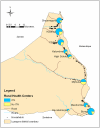Barriers to insecticide-treated mosquito net possession 2 years after a mass free distribution campaign in Luangwa District, Zambia
- PMID: 21085711
- PMCID: PMC2978084
- DOI: 10.1371/journal.pone.0013129
Barriers to insecticide-treated mosquito net possession 2 years after a mass free distribution campaign in Luangwa District, Zambia
Abstract
Background and methods: Roll Back Malaria set the goal of 100% of households in malaria endemic countries in Africa owning an insecticide-treated mosquito net (ITN) by 2010. Zambia has used mass free distribution campaigns and distribution through antenatal care (ANC) clinics to achieve high coverage.
Methodology and principal findings: We conducted a probability survey of 801 households in 2008 to assess factors associated with households that lacked an ITN after mass distribution. Community perceptions of barriers to ITN access were also obtained from in-depth interviews with household heads that reported not owning an ITN. Nearly 74% of households in Luangwa district reported owning ≥1 ITN. Logistic regression showed households without a child <5 years old during the ITN distribution campaigns were twice as likely to not have an ITN as those with a child <5 during distribution (Adjusted odds ratio (AOR) = 2.43; 95% confidence interval (CI): 1.67-3.55). Households without a woman who attended an ANC in the past 2 years were more likely to be without ITNs compared to households with a woman who attended an ANC in the past 2 years (AOR = 1.52; 95% CI: 1.04-2.21). In-depth interviews with heads of households without an ITN revealed that old age was a perceived barrier to receiving an ITN during distribution, and that ITNs wore out before they could be replaced.
Conclusions and significance: Delivery of a large number of ITNs does not translate directly into 100% household coverage. Due to their design, current ITN distribution strategies may miss households occupied by the elderly and those without children or ANC access. ITN distribution strategies targeting the elderly, those with limited access to distribution points, and others most likely to be missed are necessary if 100% ITN coverage of households is to be achieved.
Conflict of interest statement
Figures
References
-
- Lengeler C. Insecticide-treated bed nets and curtains for preventing malaria. Cochrane Database Syst Rev. 2004:CD000363. - PubMed
-
- ter Kuile FO, van Eijk AM, Filler SJ. Effect of sulfadoxine-pyrimethamine resistance on the efficacy of intermittent preventive therapy for malaria control during pregnancy: a systematic review. Jama. 2007;297:2603–2616. - PubMed
-
- WHO. Geneva: WHO; 2009. World Malaria Report 2009.
-
- Unicef. New York: Unicef and RBM; 2007. Malaria & children: Progress in intervention coverage.
-
- RBM. Geneva: Roll Back Malaria Partnership; 2008. Global Malaria Action Plan: For a Malaria Free World.
Publication types
MeSH terms
Grants and funding
LinkOut - more resources
Full Text Sources
Medical
Miscellaneous


